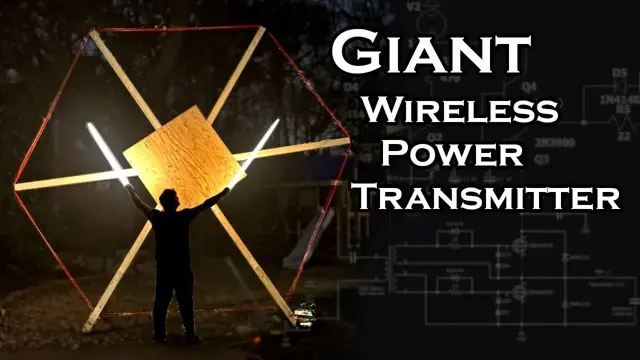2025-03-14
[public] 115K views, 9.10K likes, dislikes audio only
In this video I'll be attempting to get the longest range
possible out of a wireless power transmission system using
inductive coupling. I'll start off with a "blocking" oscillator
(similar to a joule theif) running off a 9-volt battery, and
work my way up to a resonant half-bridge driver powered from 120
volts AC.
The maximum range I achieved for lighting a single LED was 130
ft (40m), and the open circuit voltage at that range was about
2.6V.
The wireless power transmitter is a 15-ft (4.6m) hexagon with 8
turns of 14-gauge wire that oscillates at approximately 145 kHz.
This frequency is used because it's the resonant frequency of
the coil when paired with a 1.32 nF capacitor. With a 120-volt
DC input, the peak voltage across the coil can excess 10,000
volts.
The reason this is possible without a transformer is because the
high voltage peaks are on the opposite side of the coil from the
MOSFET drivers, which only see voltage between VCC and GND. The
catch is that the resonant capacitor has to be rated for the
huge voltage produced (and also handle large currents), but this
is relatively easy to do by using lots of small low-ESR film
capacitors in series/parallel combinations.
My capacitor bank used 100 33nF capacitors rated at 630VAC (2
parallel sets of 50 in series). This sort of capacitor bank
looks and functions pretty much exactly the same as the "MMC"
banks used on spark-gap tesla coils, and dual-resonant solid
state tesla coils.
By tuning the reciever coil to resonate at the same frequency as
the transmitter, maximum power transfer can be achieved. I also
added a diode and capacitor in parallel with the reciever's
resonant caps to serve as a "peak detector" so that I could
conveniently read peak voltage at resonance with a cheap
handheld multimeter.
The reciever I used in this video has an output impedance of
about 11 kOhms, so while it's not a very good current source, it
was capable of generating tremendous voltages when it was open-
circuit.
The major weakness of inductive coupling with air-cored coils is
that the power transfer is heavily dependant on the geometry of
the transmitter and reciever coils, and the power that can be
recieved at a given distance falls off dramatically with
reciever diameter.
From an RF standpoint, these coils are basically electrically
short antennas, so better coupling could probably be achieved at
much higher frequencies where the coils are sized at one-quarter
or one-half the wavelength of the transmission frequency.
Music Used:
Kevin MacLeod - Backbay Lounge

